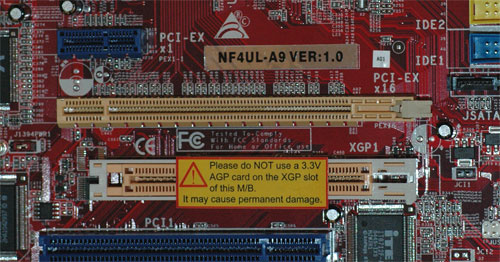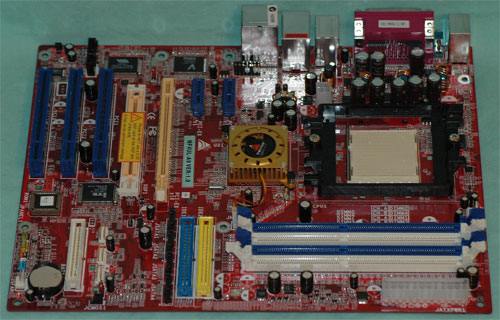nForce4 Ultra Roundup: Charting the Mainstream
by Wesley Fink on July 5, 2005 10:28 PM EST- Posted in
- Motherboards
Biostar NF4UL-A9: Features and Layout
| Specification | Biostar NF4UL-A9 |
| CPU Interface | Socket 939 Athlon 64 |
| Chipset | nForce4 Ultra (single chip) |
| BUS Speeds | 200MHz to 300MHz (in 1MHz increments) |
| PCI/AGP Speeds | Asynchronous (Fixed) |
| PCI Express | Fixed |
| Core Voltage | Startup, 1.2V to 1.625V in 0.025V increments |
| DRAM Voltage | Default, 2.7V, 2.8V, 2.9V |
| Chipset Voltage | NA |
| Hyper Transport Ratios | Auto, 1x, 2x, 3x, 4x, 5x |
| LDT Bus Transfer | 16/16, 16/8, 8/16, 8/8 |
| CPU Ratios | Startup, 4x to 25x in 1x increments |
| DRAM Speeds | Auto, 100, 133, 166, 200 |
| Memory Command Rate | Auto, 1T, 2T |
| Memory Slots | Four 184-pin DDR Dual-Channel Slots Unbuffered ECC or non-ECC Memory to 4GB Total |
| Expansion Slots | 1 x16 PCIe Slots 1 Xtreme Graphics Port (AGP 8X Form Factor) 2 x1 PCIe 3 PCI Slots |
| Onboard SATA | 4-Drive SATA 2 by nF4 |
| Onboard IDE | Two Standard NVIDIA ATA133/100/66 (4 drives) |
| SATA/IDE RAID | 4-Drive SATA 2 PLUS 4-Drive IDE (8 total) Can be combined in RAID 0, 1 |
| Onboard USB 2.0/IEEE-1394 | 10 USB 2.0 ports supported nF4 2 1394A FireWire ports by VIA VT6307 |
| Onboard LAN | Gigabit PCIe Ethernet by Vitesse VXC8201 PHY |
| Onboard Audio | Realtek ALC850 8-Channel codec with 6 UAJ audio jacks, CD-in, front audio, and optional coaxial SPDIF cable |
| Other Features | Dual-Core (x2) Support with BIOS nf4ua614 |
| BIOS | nf4ua614 |
Biostar took a different approach in the design of their nForce4 Ultra board. If you look closely at the video card slots, you will see how unique this board really is.

Even though it is not a full 8X AGP slot, the Biostar is still a unique and useful choice for those having AGP cards that they are not ready to replace. Those buyers can go to the Biostar with their current AGP card and still have the option of moving to PCIe on the same board at some time in the future. Since nForce4 does not support AGP, the Biostar allows AGP users to choose an nForce4 board anyway.
The Biostar is basically a sound board layout, particularly for a lower-priced nF4 motherboard. The 4-pin 12V power connector requires snaking the 4-pin power cable over or around the CPU, a design that many others also use. The board edge is a better location, and fortunately, the 24-pin ATX cable does reside on a board edge where it belongs. The 4 SATA connectors are a tight fit next to the PCIe slot, but they will work - even with a very long PCIe video card with dual power connectors.
The floppy connector is on the lower right edge of the board, which is certainly a better location than the bottom of the board, but still a longer reach than the preferred upper right location. Turning the IDE connectors sideways allows them to fit on the right edge near the center of the board. In most case designs, this will work fine, but a tall case with drives above the board chamber might require snaking IDE cables over DIMMs - not ideal for air flow.
BIOS controls on the Biostar were a pleasant surprise for an entry-level nForce4 Ultra motherboard. Just about every adjustment that you need for overclocking is here, including a useful vDIMM range to 2.9V, a wide CPU voltage adjustment range, and CPU ratio adjustments. The same goes for features, as our board even had dual Firewire ports controlled by a TI controller. Firewire is one of the first options to go when manufacturers build to a price point.
The only glaring omission is the lack of a standard SPDIF optical or coaxial out port. A board with 8-channel sound and 6 jacks should have a supplied SPDIF connector, not an optional feature.
We also ran into a very strange anomaly when benchmarking the XGP graphics slot. When we mounted an 8X AGP card and selected PCI as out boot video, the system booted just fine into Windows XP. However, the Gigabit LAN had mysteriously disappeared and no amount of searching for new devices would bring it back. We removed the AGP and reinstalled a PCIe video card and the Gigabit LAN was back. We hope that Biostar can find a way to correct this strange behavior in a future BIOS update.
Abit Fatal1ty AN8: Overclocking and Stress Testing
Biostar NF4UL-A9: Overclocking and Stress Testing











75 Comments
View All Comments
arfan - Wednesday, July 6, 2005 - link
"So ECS, Foxconn, Biostar - we can only suggest that you need to add features and performance that will make an AMD user want to buy your boards. "Why u think's ECS is bad ???
From your benchmark, ECS is not too bad, their ranking in the middle until top1.
Sorry, if myenglish is so bad.
smn198 - Wednesday, July 6, 2005 - link
Page 1: "There are no performance differences in the SLI and Ultra chipsets, or even the base nForce4 for that matter. These chipsets differ only in which features are available to the buyer - but they beat with the same heart."I thought the base nForce4 had a 800MHz HT where as the Ultra and SLI have 1GHz. Is that not correct?
Frallan - Wednesday, July 6, 2005 - link
For PSU requirements read the mfg websites. Especially the DFI comes with explicit requirements.480W 24pin ATX 2.0+ PSU and from experiance Id have to say that U want a 1st tier PSU on top of that. Anecdotal advices that its possible to run a DFI SLI set up overclocked from a 350W PSU exists but fact remains that a good solid 500W+ ATX 2.0+ PSU will help U with stability.
Calin - Wednesday, July 6, 2005 - link
What I want to ask: does the processor works with four DS DIMMS at 1T command rate at lower frequency? By what you say (that 2T command rate is much slower than 1T command rate), then 1T command rate at 333MHz would be faster than 2T command rate at 400MHz.Vesperan - Wednesday, July 6, 2005 - link
I love the look of that Epox board. Pity noone imports Epox products into New Zealand any more.GhostlyGhost - Wednesday, July 6, 2005 - link
Ermm.. It's "Marvell". With two l's.Heidfirst - Wednesday, July 6, 2005 - link
I think that you must have a bad example of the ABIT. A no. of other sites (HardOCP, Hexus etc.) have all been over 300 ref. clock with it.Not to mention that there is also now the non-Fatality AN8 Ultra which is cheaper & yet has better sound & 3.55Vdimm instead of 2.8V on the Fatality ...
Affectionate-Bed-980 - Wednesday, July 6, 2005 - link
I think the Neo4 should've been included even though it was in the SLI test. Same with the Asus board. Those are really important boards. I'm sure if you add up the Asus and MSI users they would outnumber Biostar + Foxconn + Chaintech + ECS. Iono. just my 2 cents. I dont want to go look at the SLI review and then compare it to this review to see other boards and do a mental benchmark merge to get hte relative performance.You know what we should make? We should make the uber super chart system. Kinda like THG's CPU charts. Just make the interactive system comparation machine. Choose a CPU, a mobo, a gfx card etc. If you bench every component (not every combo), but just CPUs vs CPUs, mobos vs mobos, you can get the relative score and construct a relative table for combinations..... hmm just a thought.
Palek - Wednesday, July 6, 2005 - link
A few mistakes made it into the final article...-------------------------------------------------
Page 7
1. The following bit does not belong in this review. Cut and paste?
"There are absolutely no PCIe slots at all on the Neo4/SLI except for the pair of x16 slots for SLI video. MSI tells us that the 2nd PCIe can function as a PCIe x1 slot if you're not using it for video, but that is it for PCIe. Does this really matter? Right now, it really isn't important, since we had a very hard time even finding a PCIe x1 LAN card for the new PCI Express. It may matter in the future, but by that time, you will likely have moved on to a newer version of whatever chipset is the latest wonder. This is particularly clear when you look at the feature set of the MSI, since it is definitely a cut above the other boards in this roundup."
2. "SPDIG" should be SPDIF, or S/PDIF if you want to be really accurate.
Page 11
1. The title row of the table is incorrect. The motherboard name should read:
"DFI LANParty UT nF4 Ultra"
2. Link to next page is also incorrect, same as above.
Page 12
1. Title of the page is incorrect, same as above.
2. Title row of the table is incorrect, same as above.
Page 13
1. "SPDIG" round two.
--------------------------------------------------
Also, do guys have any idea why placing the codec on a daughter card reduces CPU overhead? Obviously there is something more going on than just the physical relocation of the chips. Any theories or explanations?
Xenoterranos - Wednesday, July 6, 2005 - link
Just a word about the soundblaster Live on the MSI board..."That price tag [200$] may be a bit high for the average gamer who just spent most of his/her savings on a Pentium II / Voodoo2 setup, however if you're going to swallow the cost of an expensive sound card it might as well be the Creative Labs SB Live!"
That was Anandtech back in '99. And you're getting this for free! (well, almost)